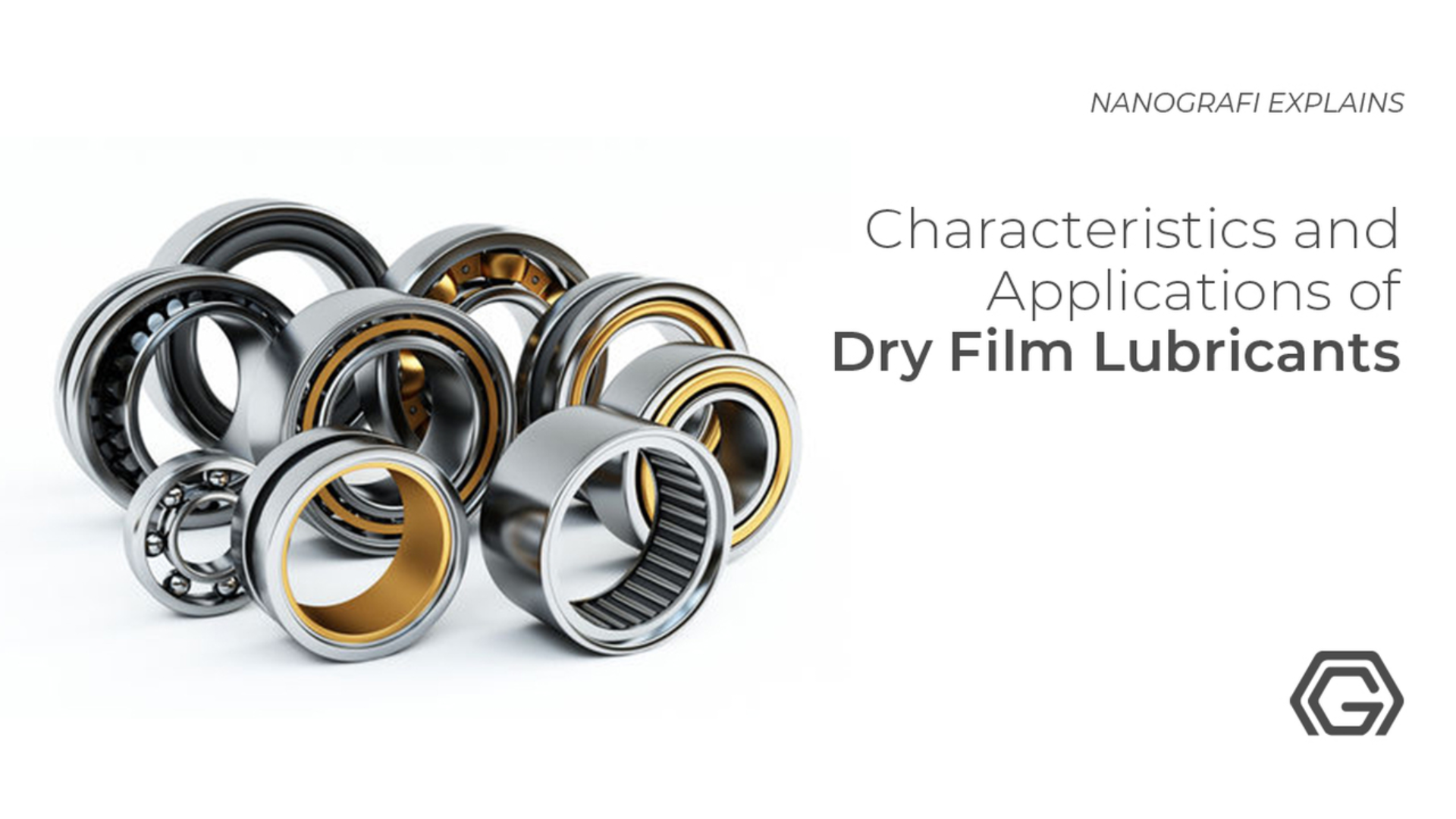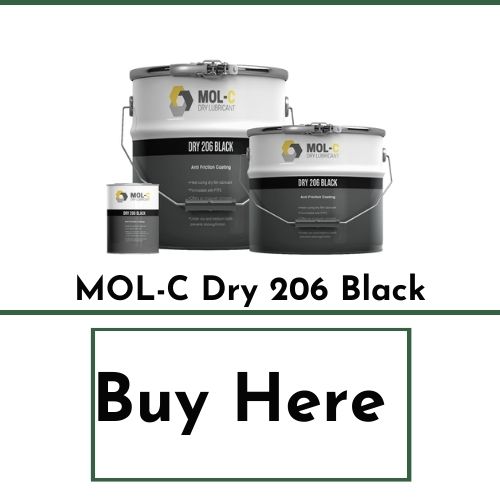Dry Lubricant Agents
Lubrication is known as the control of wear and friction. It can be a plastic, dry solid, or fluid substance. Lubrication's main objective is reducing friction. Solid or dry lubricants are materials that can lessen friction between two surfaces that are sliding against one another despite needing a liquid oil medium.
Molybdenum disulfide and Graphite are two leading dry lubricants. The lamellar structure is the reason for many solid's lubricity. Low friction and prevention of contact in between sliding components results when the lamellae orient parallel to the surface is, therefore, sliding easily over each other. For conditions such as Reciprocating motion, ceramics, high temperature, extreme contact pressures, dry lubricants are useful. Other dry lubricant agents are molybdenum disulfide, boron nitride, polytetrafluorethylene. Dry lubricants can keep your doors, drawers, windows, and locks running smoothly with no residual mess. Dry-film lubricants have benefits for and are sold into various markets: Automotive, Energy, Textiles, Aerospace, Construction, Defense, Garden Tools, O-rings, Waste Water. Dry lubrication agents have many methods of application such as Dipping/spraying/brushing, anti-friction coatings, free powders, and composites
Introduction
The control of wear and friction is known as lubrication, and it's done by introducing the friction-reducing film between moving surfaces that are in contact. Used lubricant can be a solid dry, plastic, or fluid substance and can be used in the lubrication of a surface, most commonly being grease and oil. The primary functions of a lubricant are to prevent wear, control contamination (carry contaminants to a sump or filter), reduce friction, prevent the equipment from corrosion, transmit power (hydraulics), control temperature (dissipate heat), and to provide a fluid seal. Reducing friction is a key objective of lubrication. Solid or dry lubricants are such materials that even being in the solid phase, they are capable of reducing friction between two surfaces that are sliding against one another without any need of a liquid oil medium.
A dry lubricant is a material applied as thin film or powder to reduce wear and friction of contacting surfaces in relative motion and prevent damage from happening. Oil and liquid-based lubricants offer lubrication and operate at temperatures lesser than dry lubricants. In applications like dry lubricated bearings or locks, dry lubricants are used. Such materials can operate in non-oxidizing/reducing environments (molybdenum di-sulfide up to 1100 °C, 2012 °F) and in oxidizing environments on 350 °C (662 °F). Most dry lubricants have characteristics of low-friction that are because of a layered structure on the molecular level with weak bonding in between layers that with minimal applied force are capable of sliding parallel to each other. Although, for lubrication, only a layered crystal structure isn't sufficient because there are some applications in which some solids with non-lamellar structures function as well as dry lubricants. Those some solids include polytetrafluoroethylene, rare-earth fluorides, some solid oxides, diamond, and certain soft metals (silver, lead, indium, tin).Dry lubricants that are commonly used are hexagonal boron nitride, Molybdenum disulfide (MoS2), and Graphite.
Properties of Lubricants
The lamellar structure of the solids is the reason of their lubricity. Under maximum load, lamellae orient parallel to the surface in motion's direction and slides easily over each other, leading to less friction and prevention of contact in between sliding components. In rough surfaces, particles of large size perform best at low speed, and on smooth surfaces, finer particles work best at high speed. To increase and modify their properties, these materials may be added to liquid lubricants in dry powder form.
Applications of Lubricants
Their usage provides lubrication that's long-lasting, very beneficial if cleanliness is needed and used in bad and extreme situations. Some conditions in which conventional lubricants are not up to mark, Solid lubricants are useful. Conditions like:
Ceramics: They can also be used in cases where lubricant additives that are chemically active have not been found for polymers and ceramics like surface.
Reciprocating motion: Lubrication is required to lessen wear, for instance, in lubrication of chain and gear. Solid lubricants don't escape like others, stopping from galling, corrosion, and fretting.
Extreme contact pressures: The lamellar structure orients parallel to the sliding surface, leading to high bearing-load joined with low shear stress. Solid dry lubricants are used by most applications in metal forming that involves the deformation of plastic.
High temperature: On high temperatures and environments with oxidizing atmosphere, where no other lubricant will survive, MoS2 and Graphite act as lubricants. One of the typical applications includes fasteners that after a long stay are easily unscrewed and tightened.
Most commonly used dry lubricants are:
Graphite
Planes of carbon atoms that are polycyclic compose Graphite's structure, and their orientation is hexagonal. In between planes, there is weaker bonding because the distance of carbon atoms is lingering. For air lubrication, most suitable is Graphite and for lubrication of Graphite, the necessary component is water vapor as the bonding energy in between Graphite's hexagonal planes reduces to a lesser level as compared to the energy of adhesion in between the Graphite and a substrate when the water is absorbed. In a vacuum, Graphite is not effective due to its requirement of water vapor. Galvanic corrosion can be promoted due to Graphite's electrically conductive nature. At 450 C temperature and more, Graphite is effective in an oxidative atmosphere. Then the substrate is bonded by these lubricants, and a solid film is formed thereby increasing wear life and lessening friction in railway track joints, air compressors, food industry, open gear, piano actions, and ball bearings, etc. Graphite is used. In lubricating locks, Graphite is also very common as it is different from liquid lubricants and cause no problem. In sandy environments, it is also used to lubricate the firearm's internal moving parts.
Two main groups characterize Graphite: synthetic and natural. Mining gives us natural Graphite. The higher the degree of graphitization and the carbon content, the better the resistance and lubrication to oxidation. Carbon's high purity (99.5-99.9%) characterizes Synthetic Graphite. In applications, amorphous Graphite should be chosen when a thermally insulating coating and a little lubricity is needed.
Molybdenumdisulfide
For achieving a suitable purity for lubricants, MoS2 is refined. MoS2 also has the property of east shear and its structure is the hexagonal crystal, but the lubrication performance of MoS2 is more than Graphite's, and unlike Graphite, this is effective in a vacuum. It is also used in space vehicles and CV joints.
Boron Nitride
It is a lubricant that is ceramic powder. In an oxidizing atmosphere, lubricant can resist the high temperature of 1200 °C. Also, very high thermal conductivity is contained by boron nitride. It is also known as "white graphite."
Polytetrafluorethylene
In lubricating greases and oils, as an additive polytetrafluorethylene (PTFE) is broadly used. It doesn't have a structure that's layered. PTFE's macromolecules slip along each other easily. 260 °C is the operating temperature for them. For instance, on cooking utensils, it is used as a layer of coating to offer a surface that's non-sticky. Low molecular PTFE is used by PTFE Dry Film Lubricants that increases surface adhesion, decreases friction's coefficient, and reduces problems of "slip stick". They are highly stable, nonflammable, and suitable for dry film, and anti-stick lubrication. Repeated, smooth movement is essential for the lubricant's great effectiveness to provide lubrication over a broad range of applications. The top priority of Dry Film lubricant product is clean adherence to components, cosmetic appearance, or reduction of long-term friction. They are non-migrating, they stay where applied instead of spreading into nearby areas. They provide enough durability to lubricate components for life.
For lubricating locks, Graphite is used because unlike penetrating sprays or oil; dust won't be collected by this dry lube thus not clogging the mechanism. Penetrating spray lubricant and oil is not always the best lubricant for everything around the house. Inside the house, windows, drawers, bi-fold and sliding doors, locks, cabinets, latches, and other wood, plastics, and metal surfaces, all of these need clean and dry staying lubricants. Wax, silicone, and Graphite (spray or powder) quickly dry, therefore, not attracting dust. These dry lubes resolve rare lubricating problems as compared to any other lubricant and are less expensive. Dry-film lubricants have applications in energy, automotive, textiles, construction, aerospace, O-rings, defense, wastewater, garden tools.
To get more information about lubricants,
you can read our blog post here.
Application Methods of Lubricants
Dipping/Spraying/Brushing
Commonly, the dispersion of solid lubricant as an additive in grease, water, or oil is used. After assembly, dry film lubricant can be sprayed for lubrication on inaccessible parts. After evaporation of solvent, solid lubricant is formed at room temperature by the coating cures. For lubrication and assembly of slowly-moving and highly loaded parts, pastes that are grease-like lubricants and carries solid lubricant in high percentages are used. Generally, MoS2 is contained by the black paste.
Composites
Dry lubricants, for instance, MoS2, Graphite, and some other anti-wear and anti-friction additives are frequently compounded in different kinds of sintered materials and polymers. For instance, for elastomer O-rings, carbon brushes, and sleeve bearings, etc. MoS2 is compounded in materials. For the formation of thermoplastic composites that are internally lubricated and self-lubricating, solid lubricants are compounded in plastics; therefore, MoS2 reducing friction, stick-slip, and wear. Also, in an extremely fine structure that's crystalline, it acts as a nucleating agent.
Anti-Friction Coatings
They are lubricating paints containing lubricating pigment's fine particles, for instance, Graphite or PTFE, moly disulfide, blended with a binder. After proper curing and application, the dark grey solid film is formed, and the surface of the metal is bonded with these dry or slippy lubricants. Impressive protection from corrosion is offered by special rust inhibitors that are contained by many dry film lubricants.
Free Powders
The application method that's most effective is dry-powder tumbling. Substrate's prior phosphating can improve bonding. Free powder usage has its limits, as solid particles being adhered to the substrate is inadequate to offer any service life in continuous applications. To improve in metal-forming processes or running-in conditions, a short duration of the improved slide conditions may suffice.
To get more information about Mol-C products, you can visit our official website.
Conclusion
Lubrication's main objective is reducing friction. Molybdenum disulfide and Graphite are two main dry lubricants. The lamellar structure is the reason for many solid's lubricities. Dry lubricants can keep your doors, drawers, windows, and locks running smoothly with no residual mess. Dry lubrication agents have many methods of application, such as Dipping/spraying/brushing, anti-friction coatings, free powders, and composites. Most dry lubricants have characteristics of low-friction that are because of a layered structure on the molecular level with weak bonding in between layers that with minimal applied force are capable of sliding parallel to each other. Other dry lubricants are boron nitride and polytetrafluorethylene.
To get more information, you can visit Blografi.
References
https://en.wikipedia.org/wiki/Dry_lubricant#:~:text=Dry%20lubricants%20or%20solid%20lubricants,are%20graphite%20and%20molybdenum%20disulfide.
https://www.machinerylubrication.com/Read/28766/what-is-lubrication
https://www.whitfordww.com/solutions/dry-film-lubrication/
Recent Posts
-
Turning Noise into Power: Energy Harvesting with Piezoelectric Nanogenerators
Ambient acoustic energy, once an untapped resource, is now being converted into sustainable electric …5th Mar 2025 -
Holey Super Graphene in Li-ion Batteries: Next Generation of Energy Storage
Holey Super Graphene (hG), also referred to as “holey graphene,” is redefining li-ion ba …7th Feb 2025 -
Future Communication with 5G Technology and Advanced Materials
5G technology opens the doors to a new era in communication with faster connection speeds, low laten …6th Feb 2025







